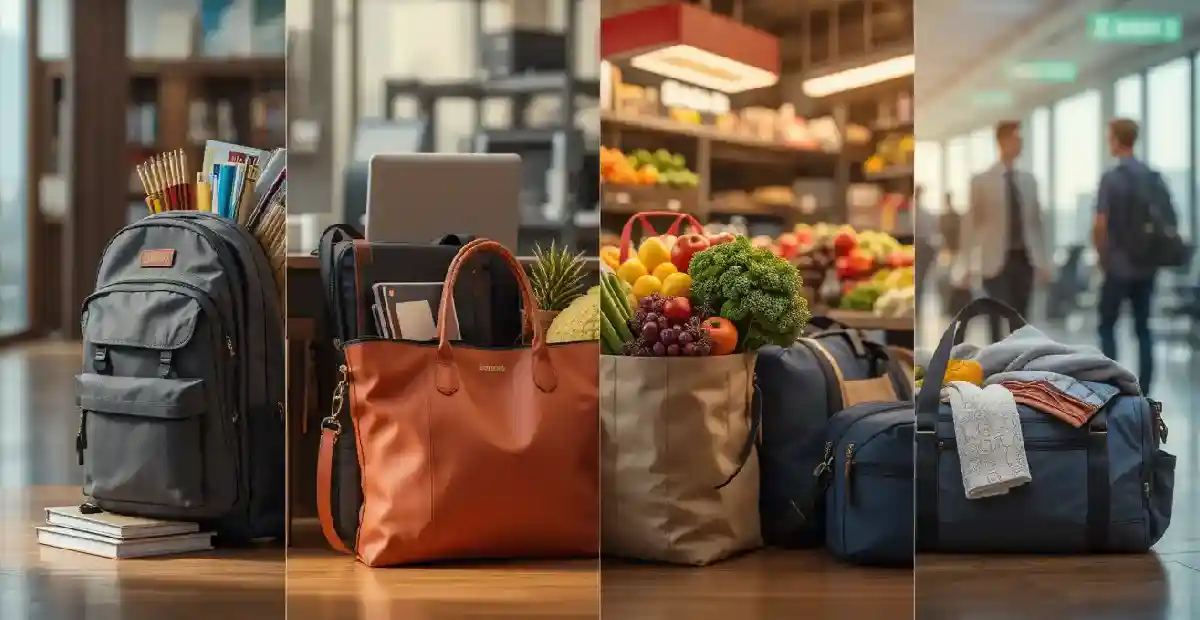Uncover the purpose of a bag and its importance in everyday life. From storage solutions to fashion statements, explore how the definition of a bag evolves across different contexts. What role do bags play in our daily routines? Dive in to find out!
Bags are one of the basic items that play a big role in making our lives easier, organizing our everyday essentials, and revealing our own fashion style. There are different types of bags — gym bags, professional briefcases, etc. — each type, suited for the needs of our activities. Recognizing how they are relevant to our daily lives shows the importance of what we carry inside our bags and how that creates convenience in the daily routine and helps us maintain our lives in an organized manner.
Historical Background of Bags (Past)
Bags are thousands of years old; practicality is where the history began. Historically, humans lacked the tools to transport other tools, food, and personal effects, and so they created primitive bags from animal hides, woven fibers, and plant materials. The original purpose of a bag was soon to be learned as these primitive bags set forth to serve a significant and basic function of storage and transport — providing communities with the means to carry their most basic essentials with them while they began to migrate and inhabit new lands and climates.
With the development of civilizations, the shape and functions of bags changed. For example, in ancient Egypt, bags were typically made from linen or leather and featured elaborate designs, demonstrating both practicality and culture. Historically their use has grown beyond simple utility to become a mark of status and craftsmanship.
During the Middle Ages, bags evolved into more sophisticated forms, such as pouches worn on a widened leather belt, or girdle. Such pouches enabled individuals to keep their valuables nearby when trading or traveling. Likewise, with the renaissance bags started to be more than just a functional item, but rather a statement piece that would highlight the wealth and personality of the owner.
Bags underwent further evolution with the advent of modern times and, most importantly, the Industrial Revolution — the mass production and manufacturing with new materials and methods. This intent allowed for more varied designs and purposes based on different social classes and lifestyle needs. Bags in the present day are numerous, ranging from bags that students use, to designer handbags that fashionistas fancy, with all bags serving an essential purpose to suit the needs of our time.
Historically, the use of a bag has always been for convenience and organization. But form and function have changed alongside our societies, technology and personal preference, which is precisely why bags have continued to serve an integral role in our lives for centuries.
What is the Purpose of a Bag?
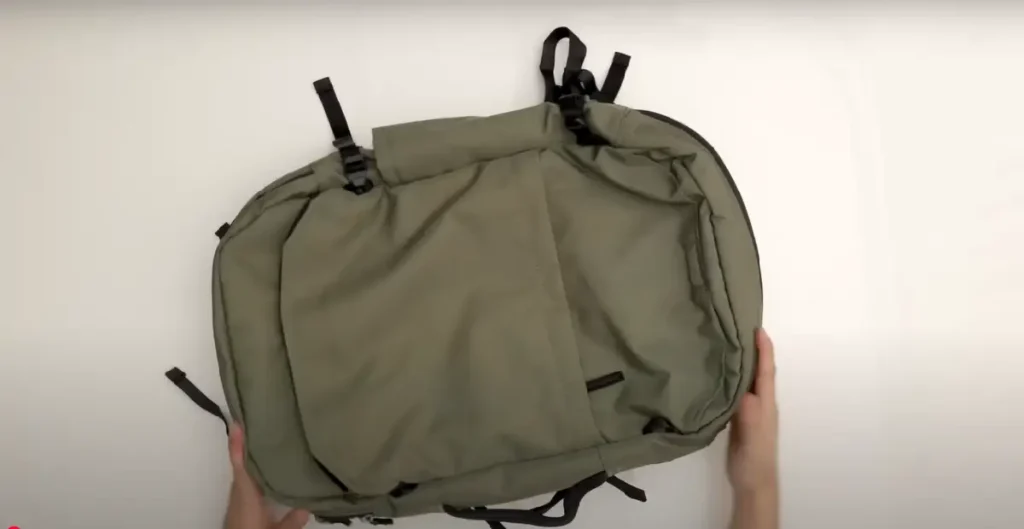
Bags have multiple functions in our day to day life which collectively contributes towards their function of being a bag. When we know these basic functions, it will help us better understand why bags can make our life more organized, stylish, and hassle-free. Here are the major categories that show the different types of utility of bags:
Storage
Bags are meant for storage after all, and quite simply one of the most fundamental functions. Bags are a product that helps keep items packed correctly so that one can carry everything they own without leaving any essentials behind. Different bags address different storage needs:
Backpacks: Perfect for students and travelers, backpacks offer plenty of room and sections for books, devices, and other personal items.
- Tote bags: Ideal for your shopping or beach trips, these practical bags still allow for larger items to come out easily, plus they remain low-weight.
- Suitcases – Suitcases are perfect for travel as they take into structure items from clothes, shoes, and essentials to have everything organized into one for travel.
Transportation
Bags are the other item that a person carries while traveling. They help to transport goods from one location to another and are essential for numerous activities. Here are a few examples:
- Diaper bags: Diaper bags allow parents to be equipped with all the necessities such as diapers, wipes, and bottles when out and about with their little ones.
- Gym Bags: Specifically for carrying your workout clothes, the gym and studio-friendly look ensures an easy transition from home to your workout.
Luggage Suitcases and bags made specially to clearly separate belongings for travel.
Style
Let us not discount the fact that bags are not just bags with practical functions, but also a style statement. A bag can make a statement with an outfit, so their styles are particularly important with personal fashion. Consider the following:
- Handbags: Handbags are usually viewed through the lens of fashion, as they come in different styles and designs, and could be a product that showcases an individual’s personality and taste.
- Messenger bags are the best of both worlds: they are functional and stylish, and they are also quite popular among students and professionals for looking good while carrying things around.
- Clutch Bags: These are smaller bags that are ideal for formal occasions as they not only act as a holding space but they can also add onto the outfit itself.
Overlapping Purposes
And the funny thing is, a lot of the bags are a hybrid of the two categories. Stylish backpack can be used for two purposes; storage and stylish — people can carry their daily belongings and have a great fashion sense. In a similar vein, a tote bag can be suitable for your groceries and an accessory for an outing.
In short, the function of a bag is designed for storage, transportation and/or style. Knowing these purposes can guide one in choosing the right bag to serve a purpose while matching his or her style.
Types of Bags and Their Modern Uses (Present)
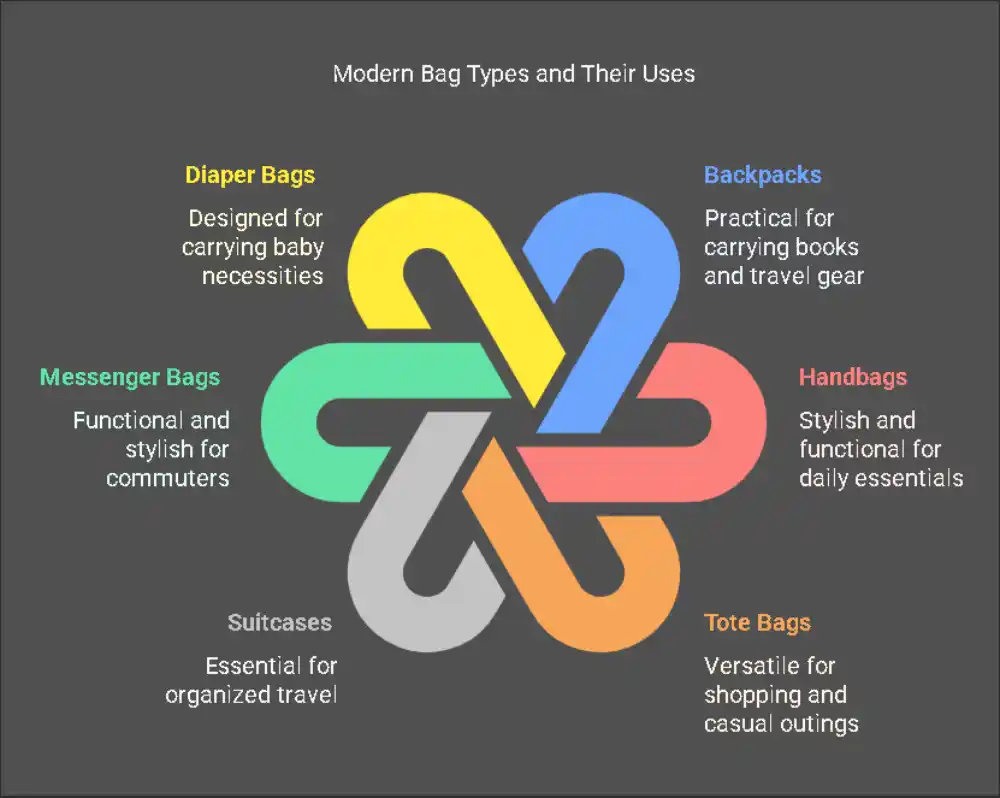
But bags have come a long way over the years in both design and ability to be able to cater for every ailment that 21st century life throws at us. Now there are many types of bags that have positive purposes and an audience to appeal to. In the next section, we look across different types of bags and ways they are being used today, and their specific roles, audiences.
Backpacks
- Purpose: A backpack is a much more practical design, you can carry a large load on your back, out of the way and use your hands in the meantime.
- Contemporary Applications: Perfect for children that require to bring books, laptop computers, and stationery from one class to an additional.
- Ideal for day trips for travelers, gives easy access for a water bottle, camera and a snack or two.
- Who it’s For: Students, travelers, and outdoors lovers needing a more portable storage option.
Handbags
- Functionality: While they might represent style more than utility, handbags still have purposes.
- CONTEMPORARY USE: Still an integral part of a purse lover’s everyday life; carrying things to the office, shopping, and dinner whilst being a trendy place to store one’s wallet, phone, and makeup.
- Best for: Women and sporty men and non-binary individuals (there are more and more styles, so stay tuned!)
Tote Bags
- Description: A tote bag is a fairly large and quite customizable item that you can store in not only functional but also stylish purposes without having to stand out.
- Contemporary Application: They are frequently used for shopping, gumming, or casual outings; these could hold anything from grocery to sports equipment.
- Who Is It For: Shoppers, people who spend a lot of time at the gym, people who like their everyday bag to be as useful as the Swiss Army knife of bags.
Suitcases
- Function: Suitcases are designed for travel and can keep clothes and other stuff safe and organized.
- Contemporary Applications: Flight essential where it aids individuals in packing smartly and provides safety when in travel. Most modern-day suitcases are equipped with wheels, locks and compartments.
- Who It Appeals To: Vacationers and business travelers in search of reasonably priced, durable and functional luggage for trips of all lengths.
Messenger Bags
- Function: Messenger bags are functional bags with a stylish touch, worn research across the body for easy reach and access.
- Today’s Uses: They are loved by commuters and students as they are perfect for carrying laptops, documents, and everyday essentials.
Who should buy: Anyone who wants a stylish and functional bag for work (and life).
Diaper Bags
- Function: Diaper bags are diaper bags, so they exist to hold the items one might reasonably need to take out of the house to care for their child.
- Contemporary Uses: They come with pouches for diapers, wipes, bottles, and attire; they allow for convenient outings with infants or toddlers.
- Ideal For: Parents or caregivers in need of a streamlined method of bringing baby essentials with you wherever you go
Clutch Bags
- Clutch bag meaning: Clutch bags are small, hand-held bags intended for special occasions.
- Current Utilization: Frequently utilized for formal gatherings, nuptials, and nightlife; they create some available room for the bare essentials, such as phones and cosmetics.
- Who It’s For: Anyone who goes to summer functions but would like a cute, portable place to hold their belongings.
Key Takeaway
Awareness of the different types of bags and their contemporary purpose assists consumers in selecting the right bag for their needs. Here, bag types are used for different purposes and cater to different audiences; like a bag for the students as a backpack and a bag for tourists as a suitcase. Choosing the right bag can have a big impact on our organization, convenience and even our style. propriate bag, individuals can enhance their organization, convenience, and personal style in everyday life.
Materials and Their Impact on Purpose
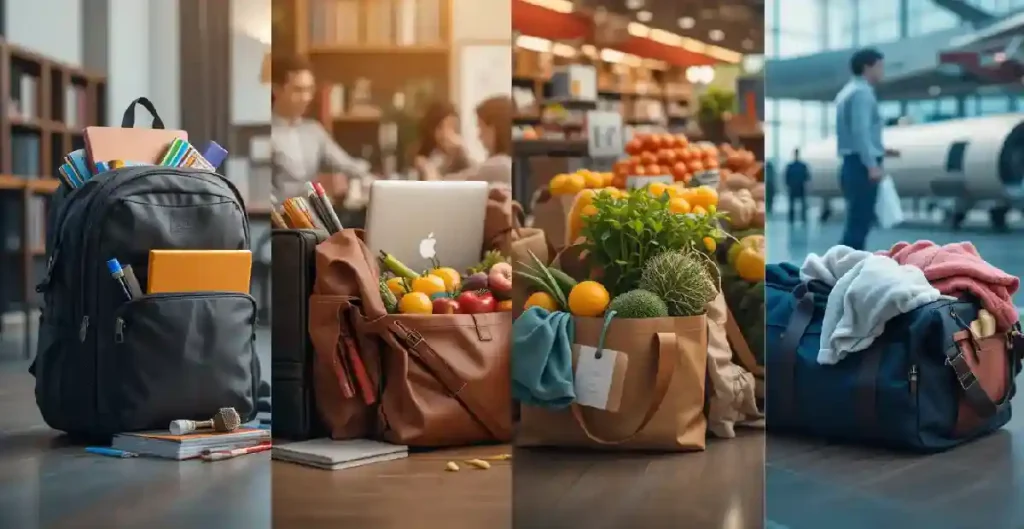
The kind of materials used while making a bag is one of the most important factors determining its function, durability, and style. Different bags need special materials to perform the task for which it is designed, but aesthetics and environmental friendliness are indeed very different. In this segment we will review the different materials used in the bags and how that influences the function of bags and the advantages and disadvantages of each.
1. Leather
Timeless Leather: This material is a classic among furniture materials, strong and durable. The best leather bags will also age beautifully and develop their own unique patina, adding to their character.
Pros:
- Toughness: Leather bags are tough, resistant to abuse and good all-rounders.
- Appeal: They offer a level of style and sophistication that makes them ideal for formal events and work environments.
Cons:
- Pricey: While some can find affordable leather bags, the cost can also peak high as well;
- Care: Regular coddling is essential to keep leather looking good — including occasional waxing to keep it properly waterproofed.
- Functionality of Leather Bags: They are usually designed for business, traveling or formal occasions where a sophisticated appearance is a must.
Canvas
Canvas Canvas is a durable, woven fabric that has a more relaxed appearance but still provides high durability.
Pros:
- Cost: Canvas bags are more cost-effective than leather bags, allowing for a larger target audience.
- Flexibility: They are easily printable and dyeable and can be used in different designs and styles.
Cons:
- Unless treated, canvas can soak up water — and that can ruin whatever being stored inside.
- Wear and Damage: Canvas bags may show evidence of wear more easily over time — fraying, fading, etc.
Contemporary Uses — Canvas bags today are largely seen in casual formal outings, grocery shopping, and travel making them something that can be used in everyday, modern life activities.
3. Synthetic Materials (e.g., Nylon, Polyester)
Durability — Synthetic fabrics tend to be lightweight, waterproof and extremely durable, making them perfect for many purposes.
Pros:
- Water Resistance: A lot of synthetic stuff is water resistant — so that means contents are better protected.
- Light Weight: Synthetic bags are generally lightweight when compared to leather or canvas bags making them easy to carry.
Cons:
- Environmental Concerns: Synthetic materials can come from petrochemicals and have sustainability and environmental destruction dilemmas.
- Lack of Style: On one hand, more functional synthetic bags may come out to be not as aesthetic for higher-end fashion aesthetics compared to leather or more natural materials.
- What are Synthetic bags used for: These materials are often found in backpacks, travel bags and sports equipment, where strength and weight are concerns.
Eco-Friendly Materials
Eco-friendly materials, such as recycled materials, organic cotton, and hemp are trending, as consumers choose sustainable over convenience.
Pros:
- Sustainable: These materials are usually sourced from renewable resources and are designed to have a minimal impact on the environment.
- Distinctive Look: In general, eco-friendly bags have textured and colored differently and can make a unique appearance from traditional and non-traditional materials.
Cons:
- Lifespan: Certain sustainable materials may not be as durable as traditional materials, affecting the long-term lifespan.
- Availability: Eco-friendly bags are not as widely available and lack consumer options.
- Modern-Day Usage: Eco-friendly bags are widely used by today’s environmentally aware shoppers for shopping trips, traveling, and daily errands.
Conclusion
What is the impact of bag materials on the purpose, use, and style of bags? A breakout of each material, like leather, canvas, man-made alternatives, and sustainable textiles, can help shoppers choose the right bag for their lifestyle. The bag material is one of the key considerations when determining the best functionality and aesthetics of a bag for your needs; whether durability, style, or sustainability is your focus.
Fashion vs. Functionality
The right blend of style and practicality is an essential component of bag design today. They are looking for bags that are not just functional but are also an extension of themselves. Here the relationship between chic in bags and functional bags — which are the current fashion trends where all join together what they are functional and shining is headlined.
The Importance of Balance
Some prioritize the look of the bag over its function while some have no real function media-usually. But these days consumers are looking for bags that serve a double purpose more than ever. A winning bag design strikes a balance between stylish and useful. For various reasons, this balance is extremely crucial:
- Lifestyle Compatibility – Consumers are looking for bags that will fit seamlessly into their daily lives, be it for work, travel, or play.
- Personal Style: Stylish bags allow someone to express their unique personality and style.
Trends in Bag Design
The increased need for substance and style is reflected in many of this season’s trendy bag designs. For some of the good examples here are a few of them:
1. Multi-Functional Bags
These are multi-purpose bags that convert: As an example, you can use a trendy backpack as a handbag thus it fits with accidental places as well as the corporate world.
2. Tech-Integrated Bags
From a tech point of view, it is already a part of daily life, so bags are designed with embedded specs for tech-oriented consumers who convert their bags into a high-end bag. Bags with USB charging ports or dedicated laptop and tablet compartments are a few of the increasingly common bags that embrace modern utility while still looking stylish.
3. Sustainable Fashion
Sustainable materials in fashionable designs are a trend driven by eco-conscious consumers. Many brands are now creating bags out of recycled components or out of organic fabrics, blending looks with the environment.
4. Minimalist Designs
Minimalism has been one of the foremost trends, characterized by simple lines and restrained sophistication. These bags are all about practicality with no extra bells and whistles and can often be used for many occasions.
5. Bold Colors and Patterns
The bold hues along with eye biting prints are back in action and bags are acting as a statement piece. This trend is perfect for consumers who want their bags to be an extension of them but also functional for their day to day lives.
Style vs. Utility
As this debate of style vs. utility rages on, it continues to attract consumers to pick sides as it is a matter of personal preference. But the best bag designs combine both in a way that forces no sacrifice from the user on either front. For example:
While a trendy handbag may include its own organizational compartments for better utility without sacrificing style, you can also invest in a standalone bag organizer that simply gets placed inside the handbag.
Today, functional backpacks come in a wide array of designs and stylish materials, giving consumers the best of both worlds: functionality and appearance.
To sum up this trend, The fashion vs function game is at its highest in bags nowadays. With changing trends, handbags also underwent many changes being pocket wearing bags that satisfy some practical needs and also these bags can be a fashion statement with clothes. And perhaps with experimenting with refreshing carious designs and materials that can all co-exist together into one bag that meets the needs of its intended audience, brands can all overcome the challenge of bringing both a chic accompaniment and a piece of ultra utility gear that any bit-bag can potentially wear.
Environmental Considerations in Bag Design
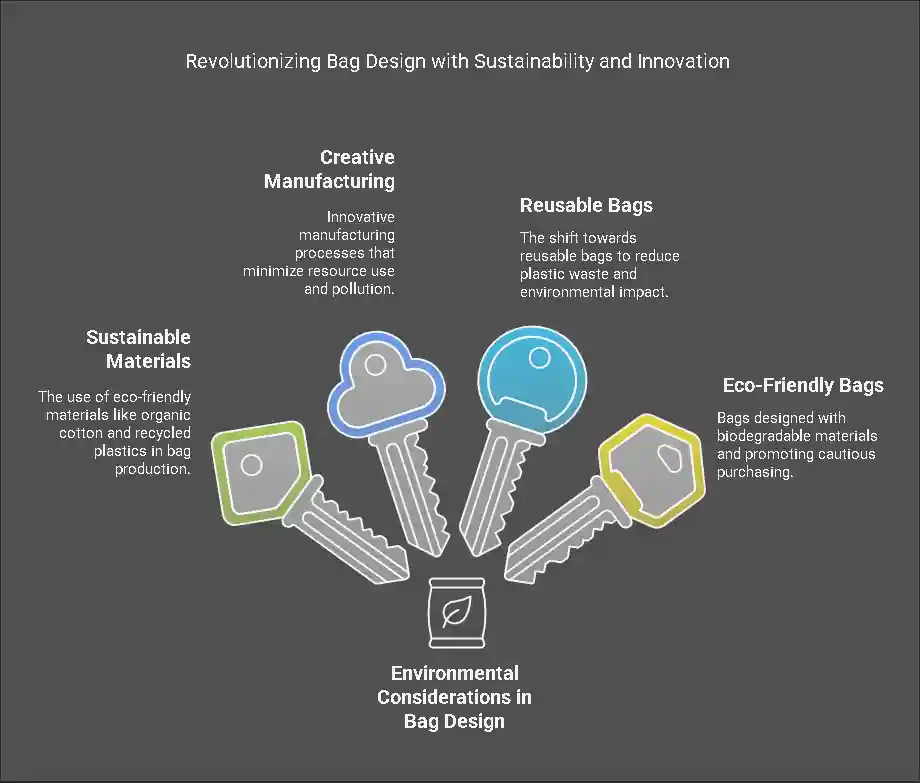
Since people are becoming more aware of the environment, the need and function of bags are also mostly shaped based on sustainability and environment-friendly status. In this segment, we discuss how environmental aspects influence bag design today, including eco bags, sustainable materials, and how the use of reusable bags among consumers has changed.
The Shift Towards Sustainability
As environmental issues surfaced, both manufacturers and consumers world-wide have started rethinking what bags are for. Traditionally known for its significant waste generation, the fashion industry is going green about it. This shift includes:
Using Sustainable Materials: A lot of brands are incorporating things like organic cotton, hemp and even recycled plastics. Such eco-friendly materials help in reducing waste and carbon footprints, which caters to the increasing need for eco-friendly products.
Creative Manufacturing Procedures: Environment-friendly styles usually utilize manufacturing techniques that minimize the use of resources and contamination. Dyeing techniques that save a lot of water are being used and some firms are also using natural dyes that are more eco-friendly; these are some examples.
The Rise of Reusable Bags
The rise in use of reusable bags reveals that, as shoppers, we are beginning to change our attitude towards plastic waste by moving away from single-use plastics. Here are some of the reasons that reusable bags can benefit us:
1. Environmental Impact
Consumers can replace disposable plastic bags with reusable alternatives, and by doing so, lessen their environmental impact substantially. One reusable bag can prevent hundreds of plastic bags from being used (and thrown away in landfills, or washed into the ocean) during its lifetime.
2. Durability and Versatility
Durability and Versatility
Reusable bags are usually durable and versatile in nature, used for grocery shopping, gym trips, or traveling. The result is a product that lasts longer, which is good for consumers and means that products don’t have to be replaced so often.
3. Awareness and Advocacy
This has also increased the public awareness of environmental issues with the rise of reusable bags. Nowadays, some consumers use eco-friendly bags deliberately and take it from one another to influence sustainability change behavior.
4. Legislative Influence
The demand for eco-friendly or reusable bags to keep the consumables due to this is also being pushed by multiple bans on single use plastics or restrictions being made by governments. Such regulations coax consumers to look for green substitutes, directing the market.
The Purpose of Eco-Friendly Bags
The green bags are not only used to carry things. They are also designed with a focus on sustainability and practicality. Key purposes include:
- Use of Biodegradable/recyclable Material: Eco-friendly bags bust the waste by using material that is biodegradable or recyclable, thus eventually leading to a cleaner planet.
- Promoting Cautious Purchasing: Eco bags tend to come with educational messages, encouraging consumers to be more cautious of their purchasing decisions and environmental effects.
- Brand Values: For some companies, environmentally responsible practices are almost a marketing tool, as they can attract consumers who value brands that are transparent about their environmental impact.
Key Takeaway
Bags have, to a greater extent, become focused on their environmental usage. Eco-friendly designs, sustainable materials, and reusable bags are on the rise as consumers become more aware of their environmental impact. With this focus on sustainability, the brands are not just making bags but also doing their fair share in assuring that the sustainability commitment that both these brands and their consumers should reflect in the form of bags as well.
Future Trends in Bag Design
Bags are going to change a lot in the future, thanks to ever-evolving innovations and awareness surrounding the environment. In the trends section, it expands on what is expected and what bag design will look like in the future, especially through the lens of smart bags, sustainability and how the changing consumer needs will change the purpose behind bags.
Technological Advancements: Smart Bags
A significant trend expected to happen in the future is the fusion of technology with bags design. Smart bags may come with some new innovations that make them more user and pocket-friendly:
1. Connectivity
You could also consider having Bluetooth technology built into future bags, and people will be able to connect their bags to their phones and benefit more from its features. For example, smart bags may be equipped with GPS tracking to find lost items, alerts to remind users of left-behind personal items, or built-in device charging ports.
2. Personalization
We might even advance to a point where bags can mold to our specific wants over another option. Smart bags may also customize compartments or settings depending on how a user employs the bag, maximizing space and ease of access.
3. Health Monitoring
With the increase in the health consciousness among the consumers, the demand of adding the health monitoring will be set to provide with the smart bags. Such as tracking physical activity, reminding users to hydrate, and all-around wellness support through the day-to-day carry, for example.
Sustainability: A Continuing Priority

In the future of bag design, sustainability is going to be one of the most determining factors. As a result, some trends will almost certainly be: Brands will continue to put a large emphasis on sustainability in their practices
1. Innovative Materials
Future bags will incorporate sustainable materials like biodegradable plastics, mycelium leather ( derived from fungi ) and recycled ocean plastics. Not only do these materials lessen the environmental footprint, they also satisfy the consumer demand for more environmentally-friendly products.
2. Circular Design
Bag designs are going to be impacted by the circular economy, meaning brands will produce items that will be easily repaired or recycled or upcycled. Modularity: Consider bags with modular parts that are replaceable and/or upgradeable, extending lifecycle and minimizing waste.
3. Transparency and Ethical Production
Mindful of the environmental concerns and ethical challenges regarding climate change, animal welfare, landscape destruction, and biodiversity, consumers are becoming more aware and conscious of their buying decisions. Consumers will opt for ethically made bags, giving brands with transparency in the sourcing and production of their products a definite edge.
Evolving Consumer Needs
With the changing lifestyle, the purpose of bags will also change too. Prospective bag design trends will be determined by changing consumer demand:
1. Versatility and Adaptability
As people work remotely and live more flexible lifestyles, consumers will want bags that work in and out of the office. Bags offering multi-function usage, especially convertible backpacks to handbag bags will be more common among people.
2. Sustainability Awareness
The consumers of today are giving preference to sustainability if every scenario of life, by this, the demand for the eco-friendly bags will rise. The consumers are environmentally aware and will be attracted to brands that have sustainability built into their offering, which has become an unmistakable winner in terms of brand loyalty.
3. Focus on Wellness
With an increased focus on health and wellness, bags that promote health and well-being may also be created. Such as supporting ergonomic carrying, bone fatigue and even bone healing behaviors.
Final Thoughts
Bag design of the future is going to be defined by technology, sustainability, and the needs of consumers. The purpose of bags will only widen, since more smart bags will be produced and production processes will adopt more sustainable practices. By anticipating such trends, brands can design stylish and practical bags for the consumers of tomorrow and remain relevant in an ever-evolving market.
Cultural Significance of Bags
Bags are also much more than just an item to carry stuff in, they are a big part of the culture in many of the world societies. In which it discusses the function of bags in various cultures, meaning of some bag types, and social ceremonial use of bags.
Bags in Different Cultures
Culturally, bags have somewhat a significance – depending on the traditions, value set, and what they seem valuable in their practicality. So here are a few instances of how stacks are utilized in various societies:
1. Ceremonial Bags
Bag is mostly used in houses but even in many cultures, bags are made for ceremonial purposes. As an example, in more traditional Indigenous cultures, the bags can be ever so intricately designed as they can be used for spiritual practices and culturally significant ceremonies. They might contain holy objects; herbs, tools, or offerings for rituals, and they always carry a memory of tradition and togetherness.
2. Functional Bags
Functional bags, as opposed to ceremonial ones, are an indispensable part of daily life in some cultures. Take large woven baskets, for example — they’re common in many African communities, often to be taken to a market to carry bulk goods or to (in my case) transport agricultural produce. These bags, while functional, also embody the handcrafted artistry of the area.
3. Fashion and Identity
Among the latest usages, bags often represent fashion that reflects individual character and culture. Bags that might be used by luxury brands as status symbols juxtaposed against locally made bags often have unique designs that celebrate cultures. The type of bag you carry speaks of your values, lifestyle, and social status.
Symbolic Meanings Associated with Specific Types of Bags
Bags have different symbolic meanings, each one adding the story of culture and values to its narrative. Below are some examples of interest:
1. Bridal Bags
Bags are an essential part of many wedding ceremonies in various cultures. They are intricate designs carrying things with meanings to fill the bridal bag for the brides on the way to getting married. These can include family heirlooms, personal keepsakes, or gifts for the groom’s family, indicating strong support for both tradition and unity
2. Hobo Bags
However in another culture, hobo bags mean freedom and planless lifestyle. Particularly reminiscent of the nomadic lifestyle, these bags signify adventure and independence. They could be considered exploratory instruments, capturing the essence of movement and adventure.
3. Fashion Handbags
The perception of expensive fashion handbags as a symbol of wealth and status, has become prevalent in contemporary consumerist culture. Style bags from brands that not only serve a function but are cultural icons such as Chanel and Gucci. Such bags might also be status symbols and fashion statements.
Conclusion
Has never been more than uttering volumes of culture. Bags mirror the values and traditions of diverse cultures, ranging from ceremonial uses to everyday practicality. Bags are an essential part of personal identity, status, and heritage. Gaining an appreciation of bags as more than their physical function, way as to consideration gives stationary and individuality as a whole.
Personalization and Customization
In today’s consumer-driven market, the trend of personalizing and customizing bags has gained significant traction. This section delves into how customization caters to individual needs and preferences and how it can transform the purpose of a bag.
The Trend of Customizing Bags
This demand for custom made bags is in tune with the shift in consumer culture, where individualism comes at premium prices. Bags have the ability to be customized to suit a unique identity and resonate with different lifestyles. Here are some of the ways that this trend is appearing:
1. Monograms and Initials
A majority of the brands allow you to add monograms or initials to the bags. It adds a unique touch to the bag, which makes the bag feel like it’s their own. They often make the most memorable gifts or heirlooms, personal bags.
2. Color and Material Choices
With a custom bag service, consumers can choose colors, patterns and materials that fit their personal style. The degree of choice available ensures that a bag can be designed to match not just an outfit but an occasion or mood, and thereby used functionally.
3. Functional Customization
Apart from the aesthetic, bags can be designed specifically to function in a particular manner. For example, travelers prefer bags with designated sections for their gadgets or additional cushioning for protection. This customization balances the practical utility of the bag with the user and personal style.
Changing the Purpose of a Bag
Personalization, customization, and personal touch do not only increase the beauty of the bags but it also gives a new outlook of the bags. Here are some of the ways that this change happens:
1. From Generic to Unique
A mass-produced bag could be intended for a specific function, while a strongly individualized bag could fulfill a very special place in its owner’s life. A personalized bag for school, for instance, could be a mere school bag — or it could represent an interest and a part of the student identity, making it a crucial part of their everyday life.
2. Enhanced Emotional Connection
Bags with a touch of personal touch are often associated with special memories. They could be linked to particular moments, events, or times in a person’s life, and that adds to the sense of attachment between person and bag. This sentimentality can take the bag from function to feature to a functional keepsake.
3. Adaptation to Lifestyle Changes
A bag that was used in the past for one purpose has the potential to take on the same purpose in the future or another purpose altogether as life circumstances change. An example of this might be a diaper bag that has pockets for baby stuff but can convert to a regular everyday bag as the child gets older. This ability allows even personalized bags to be functional and versatile.
Key Takeaway
When it comes to bags, the trend for personalization and customization is giving consumers an opportunity to show their individualism, designing bags that suit their needs. This trend emphasizes on the fact that the bond between the individuals and the objects that are in their possession is changing as their use and purpose changes from commonly used bags for carrying to personal items they love. With this greater trend in demand to create personalized bags, brands embracing customization should undoubtedly speak to consumers craving meaningful yet pragmatic designs that represent their identity.
The Impact of Bags on Daily Life
Bags are part and parcel of life — a transition that impacts daily routine, work, and even fun. In this section, we talk about why bags are a part of our daily lives and the feelings we associate with them.
Role in Daily Routines
Bags are a part of our practical day to day lives when we as pilgrims carry them around for laying them out the way it suits us. They are essential tools for:
1. Commuting
During commutes, a majority of people make use of bags to bring their luggage. From briefcases for business people to backpacks for students to a shopping tote for shoppers, bags make it easier to carry all essential items, thus allowing a seamless execution of everyday activities.
2. Work and Productivity
Bags also have a significant impact on enhancing productivity at the workplace. Functional designs with compartments for laptops, documents, and supplies help people keep their work organized and at hand, facilitating a smooth transition from one task to another.
3. Leisure Activities
Bags are also a necessity for recreation. Gym bags, picnic baskets and travel totes cater to recreational activities and promote hobbies and social events. This diverse nature promotes the enjoyment of everyday living.
Emotional and Psychological Connections
Apart from the practical aspects of bags, they usually tend to be quite emotional and psychological for the user. Look out for these connections:
1. Personal Identity
We choose our bags and they often become part of who we are. A favorite handbag or backpack is itself a testament to our taste or lifestyle — an object through which we express ourselves. And this born into connection can create a sense of ownership and pride.
2. Memories and Experiences
We carry bags along as we live our lives, our travels, graduations, new jobs — they may all be significant events that we remember our bag — whatever bag it may be — from. As a result, the nostalgia and the emotional connections with these bags can let them become your beloved thing over the years of experience.
3. Comfort and Security
Bags give a sense of comfort and security to lots of people. Having those familiar items with us can be comforting, as the bag can become a trusted companion in our everyday lives. This bond with the psyche creates a more complete experience with the use of the bag.
Conclusion
Bags are a huge part of our life, they play a significant role by adding speed to our daily routines, increasing output and making leisure time a little bit better. Also adds emotional sentiment since bags are not just something one uses, bags are something one remembers. Bags are the practical partners of our daily life — without it, our things won’t have a home, we wouldn’t have an accessory to embody our life and existence.
Bag Care and Maintenance
With good care and maintenance of our bags, we will be able to make sure that they last longer while looking good and being functional. Not all bags are created equal, and we should care for them separately because of the different usages and materials we first envisioned when buying them. Here some suggestions could help you to keep your different kinds of bags for the purpose you use and make use of it for a longer time.
Tips for Caring for Different Types of Bags
1. Leather Bags
Wipe dust and dirt regularly with a damp cloth. If the leather needs deeper cleaning, apply a leather conditioner to keep it fresh and avoid breaking.
- Storing: If you are not using the genuine leather handbag for an extended period, keep it in a dry place that is not humid or too hot. They are prone to scratches and moisture, so always put them in a dust bag.
- Protection Against Damage – Protect canvas from direct sun as well as heating system sources to prevent fading and drying out.
2. Fabric Bags
- Washing: Look for washing instructions on the care label. If you have a fabric bag, the most simple way to clean it is to wipe it with a mild soap and clean water. If they are machine-washable, choose a delicate cycle.
- Storage: Always place fabric bags in an area free from moisture to prevent mold and mildew. Do not fold them, you need to keep them in shape.
- Care: For instance, bags that would be used outdoors should use fabric protectors to repel stains and spills.
3. Synthetic Bags
- Cleansing – For synthetic bags, a damp fabric may go a protracted manner; if you need to use some detergent, avoid the difficult ones, however if you couldn’t do without it, find one without alcohol. Do not use those chemicals which will damage the material. l.
- Storing: Store synthetic bags in a well ventilated space to avoid stinks. Do not over stuff them or they will lose their shape!
- Alleviation: Inspect straps and zippers for signs of wear and tear, and act immediately to remedy the problem.
4. Backpacks and Travel Bags
- Cleaning: Remove contents and shake debris. Brush or wipe with a soft cloth. Most travel bags are machine washable, per manufacturer instructions.
- Storage: Keep packs upright or hung if possible to help them hold their shape. Leave them dry or keep them to deter any bacteria from the development of fungus.
- Care: Check zips and buckles from time to time, make sure they are working, and if a zip starts to work stuff you can lubricate it.
Common Maintenance Practices
1. Regular Cleaning
Make cleaning a habit and add it to your bag care routine so the dirt does not build up. Bags can at least be kept looking fresh with even a quick wipe.
2. Proper Storage
Keep bags into their dust bags, or in a designated area to avoid deformation, as well as keeping them away from dust and potential scratches.
3. Repairs
Repair any damages — like a broken strap or a loose thread — while they are small problems. With timely repairs, one can increase the lifespan of their bag immensely.
4. Avoid Overloading
Owing to the sinkage and other structural damage risks, excess load should be avoided in the bags of these types. REGARD WEIGHT LIMIT AND ONLY CARRY WHAT IS NECESSARY SO THE ESSENCE OF THE POCKET WILL NOT DISTURB
Final Thoughts
Proper bag care and maintenance are essential for longevity and usability. With these material-specific tips and the dosage of regular cleaning and storing, you can keep your bags looking good for years. Not only does proper maintenance keep your bags up in centuries to come, but it also makes these bags even more usable as they look to-go.
Frequently Asked Questions For purpose of a bag
What is the primary purpose of a bag?
Above all, bags are intended to house stuff, to haul stuff, and to keep stuff organized. Bags have multiple purposes like using it daily while going to your office or school, while traveling and for occasions. Providing a way to store essentials safely and reliably is not only simple but also a form of self-expression.
Are eco-friendly bags effective for everyday use?
Yup, they are perfect for day-to-day use. They are often reusable (and are almost always really durable) and are a great sustainable alternative to a plastic bag. I also move to safer bags, which cause less waste to generate; they support sustainability efforts as well as having the capacity to store everything from groceries to my personal stuff. When you use these bags, you will aid in saving the environment and you will also have a durable and fashionable choice for your everyday activities.
What are smart bags, and how do they work?
Smart bags are innovative designs that incorporate integrated technology to enhance their functionality for today’s users. Here are some key features of smart bags and how they work:
1.Charging Ports: Many smart bags come with built-in USB charging ports that allow you to charge your devices on the go. These bags typically have a battery pack that connects to the port, making it convenient to power your phone or tablet without needing an outlet.
2. GPS Tracking: Some smart bags include GPS tracking systems, which can help you locate your bag if it’s lost or stolen. By connecting to a mobile app, users can track their bag’s location in real-time, providing added peace of mind.
3. Bluetooth Connectivity: Smart bags often feature Bluetooth technology, allowing users to connect their bags to smartphones or other devices. This can enable various functionalities, such as locking or unlocking the bag remotely, receiving notifications, or even tracking your bag’s weight.
4. Integrated Sensors: Certain smart bags are equipped with sensors that monitor weight or can detect when the bag is being accessed, enhancing security and user experience.
Overall, smart bags combine style with advanced technology, catering to the needs of tech-savvy individuals and making everyday tasks more convenient.
Conclusion
To conclude, bags are multifaceted in our lives, transforming from simple carriers to a necessary item that are used every day with a fashion touch with different needs met. The meaning of a bag involves its history, use in the modern world and what makes it special in our everyday lives.
Selecting the proper bag according to its usage is crucial if we want to have the maximum utility from the bag as well as the best experience with our day-to-day life. Whether its for work, pleasure, travel, choose a bag that suits your particular requirements so that it is a faithful accessory to Have. Well now, necessity is bringing bags even higher up on the hierarchy and fraudulent needs to concern us like never before.

